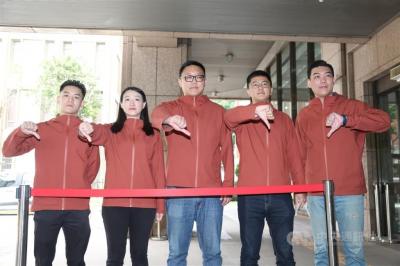Although the Ministry of National Defense and some Chinese Nationalist Party (KMT) legislators played down the significance of an incident involving two Chinese fighter aircraft in the Taiwan Strait late last month, analysts say the matter is more than simply routine.
Confirming on Monday media reports that one of two Chinese Sukhoi-27 fighter aircraft shadowing a US U-2 spy plane had crossed the median line in the Taiwan Strait on June 29, ministry officials maintained this was an isolated incident and did not regard it as provocative.
The Chinese aircraft are believed to have been from the 40th Fighter Regiment, 14th Fighter Division at Nanchang-Xiangtang Air Base in Jiangxi Province.
Although the intrusion — reportedly the first since an April 1, 2001, mid-air collision between a US Navy EP-3 aircraft and a Chinese J-8 fighter — prompted the ministry to dispatch two F-16s to intercept the Chinese fighters, KMT legislators said Beijing would not seek to provoke Taiwan at a time when relations in the Taiwan Strait are “at their best in decades.”
KMT Legislator Herman Shuai (帥化民), for one, said the incident was likely the result of pilot error.
A US Department of Defense spokesperson confirmed to the Taipei Times on Tuesday that a U-2 aircraft from the US Air Force was conducting a routine operation in international airspace in the area of the East China Sea on June 29.
As a matter of policy, the US official would not discuss details of specific missions or operations.
“In general, these reconnaissance flights are conducted in international airspace, as are the People’s Republic of China intercepts, which happen fairly routinely,” the spokesperson said. “There is no ‘repel’ aspect to them.”
US Pacific Command (PACOM), which has operational control of the surveillance flights, also confirmed the information.
A PACOM official contacted for comment said it would be inappropriate to speculate on the reasons why Chinese aircraft crossed the centerline in this particular incident.
Beijing has repeatedly called on Washington to cease the surveillance flights, claiming they infringe on its sovereignty and since 2007 China has frequently dispatched fighter aircraft close to the median line when such US surveillance flights occurred.
Asked to comment on the significance of last month’s incident, Roger Cliff, a specialist on the Chinese air force at the Project 2049 Institute, said it was more provocative than Taipei let on.
“Unless China has frequently done so in the past, which I doubt, crossing the centerline to shadow a U-2 is rather provocative,” he said. “I can’t think of any reason why China would start to do that at this particular time, but Beijing does regularly complain about intelligence and reconnaissance activities conducted against it, even when they are conducted in international waters or airspace. It is getting more assertive in its efforts to prevent them.”
Whether this was an isolated incident or another sign of China’s growing assertiveness, Taiwan should take this very seriously, Cliff said.
“Taiwan wouldn’t want the regularity with which such incidents [could] occur to cause them to stop responding. One day it might not be a probe, but rather the beginning of an actual attack on Taiwan,” he said.
Less alarmed by the incident was Gary Li, an intelligence analyst at UK-based Exclusive Analysis.
“The PLAAF [People’s Liberation Army Air Force] guys didn’t really do anything too aggressive, with one of them straying over the line for a little while,” he said, cautioning, however, that this could just be the agreed report given by both sides to avoid escalating the situation.
Asked to comment on the reasons why, barring pilot error, the PLAAF would have allowed one of its aircraft to cross the median line at this particular point in time, Li offered a number of possibilities, starting with the position that China would not have made the decision to violate the centerline lightly.
“Beijing could be sending a message to the US in light of the developments in the South China Sea by harassing their routine intelligence assets” in a matter reminiscent of the “harassing” of the USS Impeccable, a US naval survey ship, by five Chinese vessels off Hainan Island in March 2009, he said.
Another possibility, Li said, was that the U-2 was gathering intelligence that was highly sensitive — perhaps new missiles being deployed or new naval assets — which could have forced the Chinese to be more daring than they normally are.
It could also be that the frequency of surveillance missions by the US has recently increased, he said.
“Even though U-2 flights are routine, they still can monitor inland intelligence due to their altitude. So the argument that they were in international airspace doesn’t really mean much to the Chinese as far as intelligence preservation is concerned,” he said.
Li speculated that the two PLAAF aircraft were not Su-27s, but rather J-11s, as the 17,500m ceiling of the aging Su-27 would make it hard to threaten the high-altitude U-2, which usually operates at about 21,000m.
The J-11, a Chinese variant of the Russian-made Su-27, has an operational ceiling of 18,500m and is equipped with medium-range air-to-air missiles. Nanchang-Xiangtang Air Base has both Su-27UBK and J-11 aircraft.
If this was the case, the PLAAF may have wanted to demonstrate to the US that China now has the capability to threaten its high-altitude assets, Li said.

Taiwan is stepping up plans to create self-sufficient supply chains for combat drones and increase foreign orders from the US to counter China’s numerical superiority, a defense official said on Saturday. Commenting on condition of anonymity, the official said the nation’s armed forces are in agreement with US Admiral Samuel Paparo’s assessment that Taiwan’s military must be prepared to turn the nation’s waters into a “hellscape” for the Chinese People’s Liberation Army (PLA). Paparo, the commander of the US Indo-Pacific Command, reiterated the concept during a Congressional hearing in Washington on Wednesday. He first coined the term in a security conference last

Prosecutors today declined to say who was questioned regarding alleged forgery on petitions to recall Democratic Progressive Party (DPP) legislators, after Chinese-language media earlier reported that members of the Chinese Nationalist Party (KMT) Youth League were brought in for questioning. The Ministry of Justice Investigation Bureau confirmed that two people had been questioned, but did not disclose any further information about the ongoing investigation. KMT Youth League members Lee Hsiao-liang (李孝亮) and Liu Szu-yin (劉思吟) — who are leading the effort to recall DPP caucus chief executive Rosalia Wu (吳思瑤) and Legislator Wu Pei-yi (吳沛憶) — both posted on Facebook saying: “I

The Ministry of Economic Affairs has fined Taobao NT$1.2 million (US$36,912) for advertisements that exceed its approved business scope, requiring the Chinese e-commerce platform to make corrections in the first half of this year or its license may be revoked. Lawmakers have called for stricter enforcement of Chinese e-commerce platforms and measures to prevent China from laundering its goods through Taiwan in response to US President Donald Trump’s heavy tariffs on China. The Legislative Yuan’s Finance Committee met today to discuss policies to prevent China from dumping goods in Taiwan, inviting government agencies to report. Democratic Progressive Party Legislator Kuo Kuo-wen (郭國文) said

The Ministry of Economic Affairs has fined Taobao NT$1.2 million (US$36,900) for advertisements that exceeded its approved business scope and ordered the Chinese e-commerce platform to make corrections in the first half of this year or its license would be revoked. Lawmakers have called for stricter supervision of Chinese e-commerce platforms and more stringent measures to prevent China from laundering its goods through Taiwan as US President Donald Trump’s administration cracks down on origin laundering. The legislature’s Finance Committee yesterday met to discuss policies to prevent China from dumping goods in Taiwan, inviting government agencies to report on the matter. Democratic Progressive Party